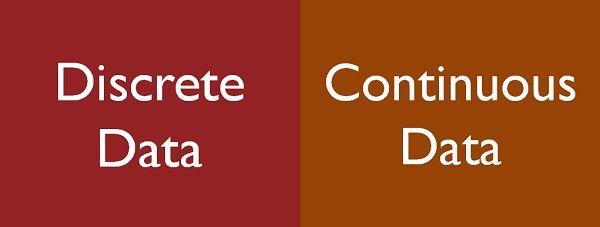Difference Between a Discrete and Continuous Randon Variable
 In statistics, data is defined as the facts and figures collected together for the purpose of analysis. It is divided into two broad categories, qualitative data, and quantitative data. Further, the qualitative data is cannot be measured in terms of numbers and it is sub-divided into nominal and ordinal data. On the other hand, quantitative data is one that contains numerical values and uses range. It is sub-classified as discrete and continuous data.Discrete data contains finite values that have nothing in-between
In statistics, data is defined as the facts and figures collected together for the purpose of analysis. It is divided into two broad categories, qualitative data, and quantitative data. Further, the qualitative data is cannot be measured in terms of numbers and it is sub-divided into nominal and ordinal data. On the other hand, quantitative data is one that contains numerical values and uses range. It is sub-classified as discrete and continuous data.Discrete data contains finite values that have nothing in-between
As against,continuous data contains data that can be measured, that includes fractions and decimals. Take a read of the article to know the difference between discrete and continuous data
Content: Discrete Data Vs Continuous Data
- Comparison Chart
- Definition
- Key Differences
- Conclusion
Comparison Chart
| Basis for Comparison | Discrete Data | Continuous Data |
|---|---|---|
| Meaning | Discrete data is one that has clear spaces between values. | Continuous data is one that falls on a continuous sequence. |
| Nature | Countable | Measurable |
| Values | It can take only distinct or separate values. | It can take any value in some interval. |
| Graphical Representation | Bar Graph | Histogram |
| Tabulation is known as | Ungrouped frequency distribution. | Grouped frequency distribution. |
| Classification | Mutually Inclusive | Mutually Exclusive |
| Function graph | Shows isolated points | Shows connected points |
| Example | Days of the week | Market price of a product |
Definition of Discrete Data
The term discrete implies distinct or separate. So, discrete data refers to the type of quantitative data that relies on counts. It contains only finite values, whose subdivision is not possible. It includes only those values that can only be counted in whole numbers or integers and are separate which means the data cannot be broken down into fraction or decimal.
For example, Number of students in the school, the number of cars in the parking lot, the number of computers in a computer lab, the number of animals in a zoo, etc.
Definition of Continuous Data
Continuous data is described as an unbroken set of observations; that can be measured on a scale. It can take any numeric value, within a finite or infinite range of possible value. Statistically, range refers to the difference between highest and lowest observation. The continuous data can be broken down into fractions and decimal, i.e. it can be meaningfully subdivided into smaller parts according to the measurement precision.
For Example, Age, height or weight of a person, time taken to complete a task, temperature, time, money, etc.
Key Differences Between Discrete and Continuous Data
The difference between discrete and continuous data can be drawn clearly on the following grounds:
- Discrete data is the type of data that has clear spaces between values. Continuous data is data that falls in a continuous sequence.
- Discrete data is countable while continuous data is measurable.
- Discrete data contains distinct or separate values. On the other hand, continuous data includes any value within range.
- Discrete data is graphically represented by bar graph whereas a histogram is used to represent continuous data graphically.
- Tabulation of discrete data, done against a single value, is called as an ungrouped frequency distribution. On the contrary, tabulation for continuous data, done against a group of value, called as grouped frequency distribution.
- Overlapping or mutually exclusive classification, such as 10-20, 20-30,.., etc. s done for continuous data. As opposed to, non-overlapping or mutually inclusive classification like 10-19,20-29,…., etc. is done for discrete data.
- In a graph of the discrete function, it shows distinct point which remains unconnected. Unlike, continuous function graph, the points are connected with an unbroken line
Conclusion
Hence, with the above explanation and example, it would be quite clear that the two types of data are different. Discrete data expects a certain number of isolated values. In contrast to continuous data, which expects any value from a given range (without any breaks), and is related to physical measurement.
Source: https://keydifferences.com/difference-between-discrete-and-continuous-data.html